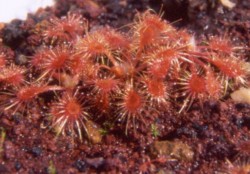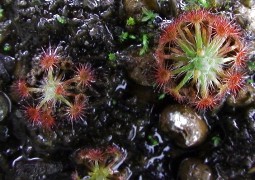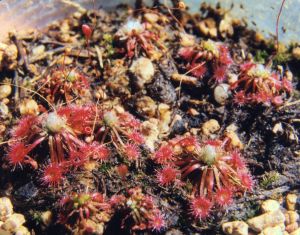PYGMY DROSERA
You'll find them only in Australia sometimes in really specific areas. Weather change during year is particular to Australia as their environment. So they are special plants often wonderful and very small. Their annual cycle can be sum up like this:
Cool winter but not too much with rainy days and a lot of air humidity. At this time they grow less or more fast and seeds start growing. At spring it's full growth and first flowers. Summer is very hot and dry so it is dormancy for many pygmy droseras. Most of them produce a stipule bud to save themselves from hard sunrays. And them autumn comes with its first rains and cold that end up dormancy. Some pygmy drosera produce gemma that allow them to reproduce without seeds.
Their cultivation is not too hard if you follow this cycle and provide them enough light and humidity. Allen Lowrie's books could be very useful especially Tome 2. Unfortunately it's very difficult to find it.
- Drosera eneabba grows in west-south-west Australia and live on sandy ground.
- Drosera ericksoniae comes from west-south-west Australia. It reaches 3 cm in diameter and is very often an annual plant.
- Drosera leucoblasta grows in south-west Australia. It produces a big orange flower.
- Drosera occidentalis "beermullah" from south-west Australia (Perth). It's one of the smalliest (1.5 cm diameter).
- Drosera paleacea ssp. Paleacea is a specy from south-west Australia (Perth, Albany).
- Drosera pulchella is a specy from south-west Australia. It's leaves are big enough compare to other pygmy.
- Drosera pygmaea is one of the easiest to grow and as its name says it's really minute.
- Drosera X badgerupii is coming from N.E. of Perth, it looks like its parents and has a very nice flower.
Drosera eneabba :
| Temp. (°C / °F) | Gemmes / bud | Climate | Origin | Remarks | |
| min. | max. | yes / yes | Warm temperate | S.W. Aust.(North from Perth) | Dry summer dormancy |
| 5 / 41 | 38 / 100 | ||||
 Wonderfull small plant. It produces lots of gemmae so it's easy to reproduce it. Take care main plant will be tired after this.
Wonderfull small plant. It produces lots of gemmae so it's easy to reproduce it. Take care main plant will be tired after this.
Drosera ericksoniae :
| Temp. (°C / °F) | Gemmes / bud | Climate | Origin | Remarks | |
| min. | max. | yes / no | Warm temperate | S.W. Aust. (from Northam to Kalbarri) | Summer dormancy, barely damp |
| 5 / 41 | 38 / 100 | ||||
 It has long leaves and is rather big for a pygmy drosera. Its cultivation is really the same as D.pygmaea. Summer dormancy is not very deep but important. I grow it from seeds without any difficulty.
It has long leaves and is rather big for a pygmy drosera. Its cultivation is really the same as D.pygmaea. Summer dormancy is not very deep but important. I grow it from seeds without any difficulty.
Drosera leucoblasta :
| Temp. (°C / °F) | Gemmes / bud | Climate | Origin | Remarks | |
| min. | max. | yes / yes | Warm temperate | S.W. Aust. (around and W. from Esperance) | Dry summer dormancy |
| 5 / 41 | 38 / 100 | ||||
 It looks like D.eneabba but produce less gemmae and the main is near to die after that. Don't forget to sow these gemmae in case of. They will grow without any difficulty.
It looks like D.eneabba but produce less gemmae and the main is near to die after that. Don't forget to sow these gemmae in case of. They will grow without any difficulty.
Drosera occidentalis "beermullah" :
| Temp. (°C / °F) | Gemmes / bud | Climate | Origin | Remarks | |
| min. | max. | yes / yes | Warm temperate | S.W. Aust. | Dry summer dormancy |
| 5 / 41 | 38 / 100 | ||||
 Very small like D.pygmaea. Its cultivation is the same but it seems to be more sensitive to its environment (reacts more strongly to variation). Its dormancy must be drier too.
Very small like D.pygmaea. Its cultivation is the same but it seems to be more sensitive to its environment (reacts more strongly to variation). Its dormancy must be drier too.
Drosera paleacea ssp. Paleacea :
| Temp. (°C / °F) | Gemmes / bud | Climate | Origin | Remarks | |
| min. | max. | yes / yes | Warm temperate | S.W. Aust. (from Perth to Albany) | Dry summer dormancy |
| 5 / 41 | 38 / 100 | ||||
 It looks like D.leucoblasta that has been reduced to 2/3 with pinky hairs. It doesn't seem to be a fast grower and didn't produce much gemmae. Perhaps because it is yet too young. Few gemmae that were produced had grown up without any difficulty.
It looks like D.leucoblasta that has been reduced to 2/3 with pinky hairs. It doesn't seem to be a fast grower and didn't produce much gemmae. Perhaps because it is yet too young. Few gemmae that were produced had grown up without any difficulty.
Drosera pulchella :
| Temp. (°C / °F) | Gemmes / bud | Climate | Origin | Remarks | |
| min. | max. | yes / no | Warm temperate | S.W. Aust. | Slow down in summer, barely damp |
| 5 / 41 | 38 / 100 | ||||
 This one has the largest leaves that makes it look different from the others. Its cultivation is near the same with a light dormancy. It's easy too to reproduce it by gemmae.
This one has the largest leaves that makes it look different from the others. Its cultivation is near the same with a light dormancy. It's easy too to reproduce it by gemmae.
Drosera pygmaea :
| Temp. (°C / °F) | Gemmes / bud | Climate | Origin | Remarks | |
| min. | max. | yes / no | Warm temperate | S.E. Aust..(Brisbane coast, Adelaide and Tasmania), New Zealand | Slow down in summer, barely damp |
| 5 / 41 | 38 / 100 | ||||
 I have planted some seeds this winter and now since it's warm I have many shoots. They are really small, It grows abundantly but shoots stay small(less than 2 inches). It seems to be easy to grow but, because of its size, it needs to be protected from hard rain and other plants around it that could grow over. You have to consider too that it needs high level of humidity when the plant is young otherwise it could dry easily. I have some trouble with the heat of summer. The end of leaves doesn't grow anymore even with humidity. It begins its summer latency period as in its natural condition, hot and dry. But my plants are not big enough. To make it grow more and more there is a balanced point to find between warm and humidity, but it's not easy. It seems to be possible as some of my plants, those which are in full sun, are flowering and begining to make something like a rosette in the center (which should become gemmae). If you do your seedlings earlier than me in the season you will not have any trouble.
I have planted some seeds this winter and now since it's warm I have many shoots. They are really small, It grows abundantly but shoots stay small(less than 2 inches). It seems to be easy to grow but, because of its size, it needs to be protected from hard rain and other plants around it that could grow over. You have to consider too that it needs high level of humidity when the plant is young otherwise it could dry easily. I have some trouble with the heat of summer. The end of leaves doesn't grow anymore even with humidity. It begins its summer latency period as in its natural condition, hot and dry. But my plants are not big enough. To make it grow more and more there is a balanced point to find between warm and humidity, but it's not easy. It seems to be possible as some of my plants, those which are in full sun, are flowering and begining to make something like a rosette in the center (which should become gemmae). If you do your seedlings earlier than me in the season you will not have any trouble.
Drosera X badgerupii :
| Temp. (°C / °F) | Gemmes / bud | Climate | Origin | Remarks | |
| min. | max. | yes / yes | Warm temperate | S.W. Aust. | Dry summer dormancy |
| 5 / 41 | 38 / 100 | ||||
 This hybrid (nitidula ssp.omissa X occidentalis ssp.occidentalis) looks like its parents and seems to be stronger. It grows faster and produce more gemmae than D.occidentalis. Its cultivation is of course the same. In fact it's probably the easiest one. It makes many gemmae and seeds.
This hybrid (nitidula ssp.omissa X occidentalis ssp.occidentalis) looks like its parents and seems to be stronger. It grows faster and produce more gemmae than D.occidentalis. Its cultivation is of course the same. In fact it's probably the easiest one. It makes many gemmae and seeds.
Last modification on Saturday 08/02/2008
URL: http://gelinaud.free.fr/carni/pagdyn.php